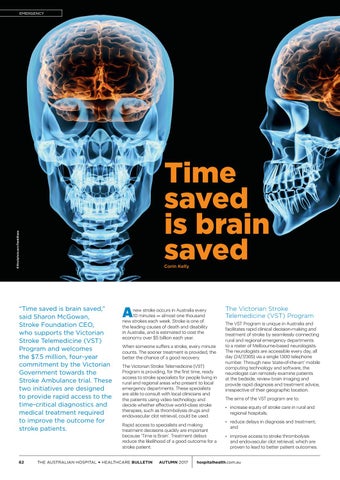EMERGENCY
© iStockphoto.com/DawidKasza
Time saved is brain saved Corin Kelly
“Time saved is brain saved,” said Sharon McGowan, Stroke Foundation CEO, who supports the Victorian Stroke Telemedicine (VST) Program and welcomes the $7.5 million, four-year commitment by the Victorian Government towards the Stroke Ambulance trial. These two initiatives are designed to provide rapid access to the time-critical diagnostics and medical treatment required to improve the outcome for stroke patients.
62
A
new stroke occurs in Australia every 10 minutes — almost one thousand new strokes each week. Stroke is one of the leading causes of death and disability in Australia, and is estimated to cost the economy over $5 billion each year. When someone suffers a stroke, every minute counts. The sooner treatment is provided, the better the chance of a good recovery. The Victorian Stroke Telemedicine (VST) Program is providing, for the first time, ready access to stroke specialists for people living in rural and regional areas who present to local emergency departments. These specialists are able to consult with local clinicians and the patients using video technology and decide whether effective world-class stroke therapies, such as thrombolysis drugs and endovascular clot retrieval, could be used. Rapid access to specialists and making treatment decisions quickly are important because ‘Time is Brain’. Treatment delays reduce the likelihood of a good outcome for a stroke patient.
THE AUSTRALIAN HOSPITAL + HEALTHCARE BULLETIN
AUTUMN 2017
The Victorian Stroke Telemedicine (VST) Program The VST Program is unique in Australia and facilitates rapid clinical decision-making and treatment of stroke by seamlessly connecting rural and regional emergency departments to a roster of Melbourne-based neurologists. The neurologists are accessible every day, all day (24/7/365) via a single 1300 telephone number. Through new ‘state-of-the-art’ mobile computing technology and software, the neurologist can remotely examine patients at the bedside, review brain imaging and provide rapid diagnosis and treatment advice, irrespective of their geographic location. The aims of the VST program are to: • increase equity of stroke care in rural and regional hospitals; • reduce delays in diagnosis and treatment; and • improve access to stroke thrombolysis and endovascular clot retrieval, which are proven to lead to better patient outcomes.
hospitalhealth.com.au
